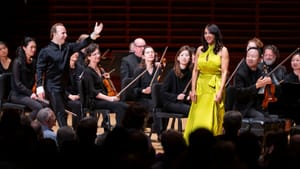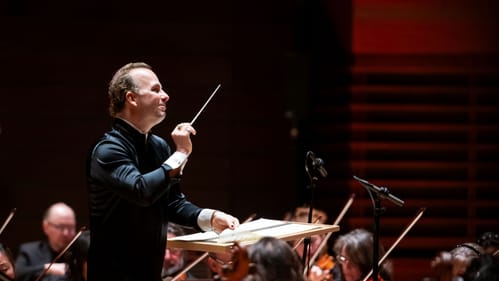Stay in the Loop
BSR publishes on a weekly schedule, with an email newsletter every Wednesday and Thursday morning. There’s no paywall, and subscribing is always free.
Peerless Price, bold Beethoven
The Philadelphia Orchestra presents Florence Price and Beethoven’s Ninth

Drama, energy, and a couple of shocking surprises were the order of the day as the Philadelphia Orchestra, under the direction of Yannick Nézet-Séguin, offered a program of Florence Price and Beethoven on Friday. It was the start of the Memorial Day weekend, but I felt sorry for revelers stuck in traffic on their way to the shore while the Philadelphians were crushing it in Marian Anderson Hall (the opening performance of a sold-out run through Thursday, May 29).
Passion and originality
Let’s start off with Florence Price’s Piano Concerto in One Movement, featuring soloist Lara Downes. Premiered in Chicago in 1934, the concerto is a substantive work of imposing compositional structure and spine-tingling emotional flair. Downes brings passion and expressive originality to what is actually a three-movement concerto offered without pause, with the traditional fast-slow-fast configuration, infused with spiritual meaning and ending with elements of a juba, or syncopated plantation dance. Orchestration was reconstructed from researched notes by Trevor Weston.
In this performance, Nézet-Séguin emphasized the ebb and flow of the concerto’s dynamics, as though he were conversing with an old friend. This isn’t surprising, since he has championed the work of Price in recent years, the orchestra under his direction winning a 2021 Grammy for a recording of two of her symphonies.
Attired in a dazzling chartreuse gown, Downes brought sophistication and a high level of musicianship appropriate to this important work. Her encore was a nuanced setting by H.T. Burleigh of the spiritual Nobody Knows the Trouble I’ve Seen.
Extraordinary, taxing, beloved
The high energy created by the Price concerto was a fitting prelude to Nézet-Séguin’s very individualized reading of one of the most well-known and beloved works in the symphonic repertoire, Beethoven’s Symphony No. 9 in D Minor, op. 125, the “Choral.” Last year was the 200th anniversary of its first performance in Vienna, Austria, the composer’s home for most of his life. Beethoven may have escaped the starving artist stigma thanks to a loyal bevy of supporters, but he did not escape affliction, losing his hearing beginning in his 20s and suffering varying degrees of deafness until his death at age 56 in 1827. That deafness was most apparent during the first performance of the Ninth, in which the composer had to be gently turned around to see the riotous applause he could not hear.
It has always surprised me to read about the positive responses of audience members to this premiere. This music is so extraordinary, parts of it incalculably ahead of its time, and more taxing on listeners and performers (especially singers) than anything preceding it. And yet it was loved and is loved, in part because of the audacity of Friedrich Schiller’s poem, which, in a historic first, introduces the human voice into the symphonic universe. But even more important is the message of that poem, supported by music, that celebrates joy and prays for peace and brotherhood among humankind, a message we need to hear and heed now more than ever.
The bad boys of the symphony
The Ninth has four movements (sections), and here, Nézet-Séguin revealed himself as much a rule-breaker as the notoriously bad-boy Beethoven. I have never heard a performance of the first movement to this symphony as bold and edgy as this rendition, which called on us to reorient our expectations and surrender to the sound. The first three movements are typically conducted in so tame a manner that I have heard many casual listeners admit they would gladly bypass them and cut straight to the sizzling finale. After all, this is a long work, about an hour and a quarter in length. Yet, this conductor’s interpretation was something new. Not only were the first three movements not dispensable, they were absolutely essential. Despite their vigor and integrity, they did not in any way detract from the final soul-shaking movement, but rather built a pathway to its glorious conclusion.

The finale began with what is perhaps my only real criticism of this performance: a very loud percussive rendition of the “terror chord” that opens the movement. I liked the loud percussive effect, but where were the actual musical notes that make your eardrums cringe and your heart beat a little faster? The volume was great, but the grit was missing. This was almost the same further on in the movement when the chord is repeated. However, this twinge was quickly forgotten and recompensed later in the score by a stroke of genius I’ll get to in a little while.
The divine spark
It says something (positive) about a musical community when we take excellence for granted. I expected nothing but the best from this assembly of orchestra, Philadelphia Symphonic Choir (directed by Amanda Quist), and soloists, and they did not fail to deliver. After the workout in the Price concerto, and the mind-expanding experiences of the first three movements, all the artists were on their toes and delivering music and inspiration at the highest level. The brilliance of Ryan McKinny’s bass-baritone voice interrupted Beethoven’s orchestral chattering with a clear command: “Friends! No more of these sad tones!” With his admonition, the choir followed with one of the most familiar and beloved chorales in world music, the Ode to Joy: “Freude, schöner Götterfunken (Joy, divine spark of the gods)…”
Singing the additional solo and small-group verses were soprano Leah Hawkins, mezzo-soprano Rihab Chaieb, and tenor Issachah Savage, forming a powerhouse quartet with McKinny that shone out against and among the melodious roar of the chorus. Nézet-Séguin kept everything together, moving with a single, unassailable momentum and a spectacular—and, to me, unexpected—touch. At the end of the fourth stanza, at the line, “Und der Cherub steht vor Gott (And the cherub stands before God),” Beethoven has the chorus intone the word “God” twice. Then, on the third time, at a deafening fortissimo, the point where he is dramatically changing time signature and key, Beethoven adds to the score a fermata, a symbol which resembles a startled human eye. This symbol instructs conductors to hold that last note as long as they feel is necessary. And Nézet-Séguin holds it … and holds it … and holds it longer and more dramatically than anything I could have imagined. If that isn’t the divine spark, I don’t know what is.
What, When, Where
Ode to Joy: Beethoven’s Symphony no. 9. Florence Price, Piano Concerto in One Movement; Beethoven, Symphony No. 9 in D Minor, Op. 125, the “Choral.” Conducted by Yannick Nézet-Séguin. $89-$234. Lara Downes, piano; Leah Hawkins, soprano; Rihab Chaieb, mezzo-soprano; Issachah Savage, tenor; Ryan McKinny, bass-baritone. Philadelphia Symphonic Choir; Amanda Quist, director. May 23, 24, and 29, 2025, at Ensemble Arts Philly’s Marian Anderson Hall, 300 S Broad Street, Philadelphia. (215) 893-1999 or philorch.org.
Accessibility
The Kimmel Cultural Campus is an ADA-compliant venue. Patrons can purchase wheelchair seating or loose chairs online by calling (215) 893-1999 or emailing patron services. With advance notice, patron services can provide options for personal care attendants, American Sign Language, Braille tickets and programs, audio descriptions, and other services.
Sign up for our newsletter
All of the week's new articles, all in one place. Sign up for the free weekly BSR newsletters, and don't miss a conversation.

 Linda Holt
Linda Holt